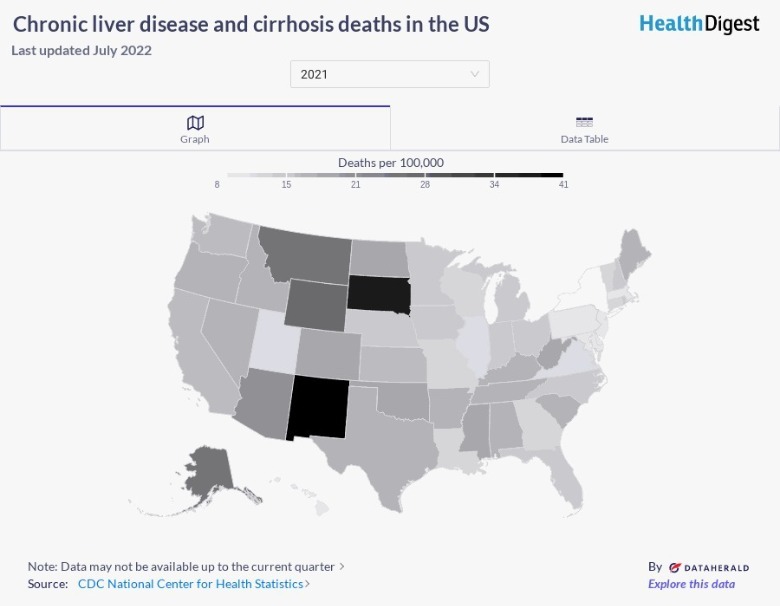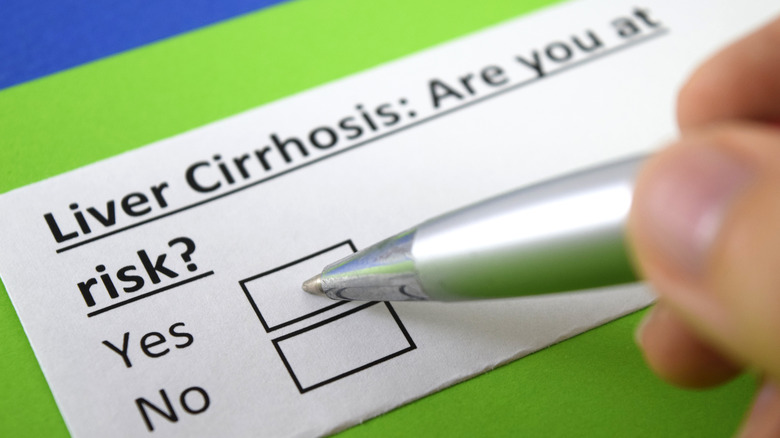This State Had The Most Deaths From Chronic Liver Disease And Cirrhosis In 2021
An estimated 4.5 million Americans are living with liver disease, according to data from the U.S. Centers for Disease Control and Prevention (CDC). Additionally, a 2019 scientific review published in the Journal of Hepatology outlines that an annual 2 million deaths across the globe are a result of liver disease, about half of which stem from cirrhosis complications.
As defined by the Cleveland Clinic, liver disease pertains to any health condition that causes damage to the liver. Liver disease can eventually progress into cirrhosis, a condition in which scar tissue overtakes healthy liver tissue and impacts the organ's ability to function. In severe cases, liver disease can result in liver failure or liver cancer.
Causes of liver disease can vary. The condition may develop out of certain viral infections, autoimmune disorders, or health conditions, like diabetes or obesity. While some liver conditions may not present with any symptoms, such as nonalcoholic fatty liver disease, people with other forms of liver disease may experience yellowing of the skin or eyes, abdominal pain, fatigue, nausea, and swelling in the extremities, amongst other symptoms.
States with the highest and lowest numbers of liver disease-related deaths
Data shows that death rates from liver disease and cirrhosis vary greatly across states. In 2021, the three states with the greatest number of liver disease-related deaths were located in the Midwest and Western United States. Wyoming had the third highest death rate, standing at 26.7 per every 100,000 deaths. South Dakota came in with the second highest rate at 37.3 per 100,000 deaths. Out of all 50 states, New Mexico was found to have the greatest number of deaths at 40.8 per every 100,000.
The three states with the lowest number of liver disease and cirrhosis-related deaths in 2021 were located in the Northeast region of the U.S. At 9.4 per every 100,000 deaths was New Jersey. Maryland had the second lowest death toll at 9.3. Even fewer was New York, with 8.2 per every 100,000 deaths.
More recently, researchers have been taking a more in-depth look at what specific factors may be linked with these statistical differences in liver and cirrhosis-related deaths by region.
Contributing factors to variations in death rates across states
Research shows a link between rates of liver disease-related deaths and specific demographic factors. In a 2019 scientific analysis published in The American Journal of Medicine, researchers determined that liver disease mortality rates were highest in the South and Midwest regions of the U.S. The median household income was amongst the top influencing factors identified. Specifically, areas with lower household incomes, as well as regions with greater racial diversity, were found to have higher rates of death from liver disease. In line with these findings, 2020 data from the U.S. Census shows that median household income fell over 3% in Midwestern regions of the country compared to 2019. Similarly, the South saw a 2.3% decrease in household income, while the Northeast did not see a significant difference.
Researchers from a 2021 study published in Hepatology Communications suggest that barriers to healthcare services across states also likely contribute to these differences in numbers. The study team emphasized in their research the need for policy leaders to better address the health disparities amongst states to help reduce rates of liver disease and related death.



